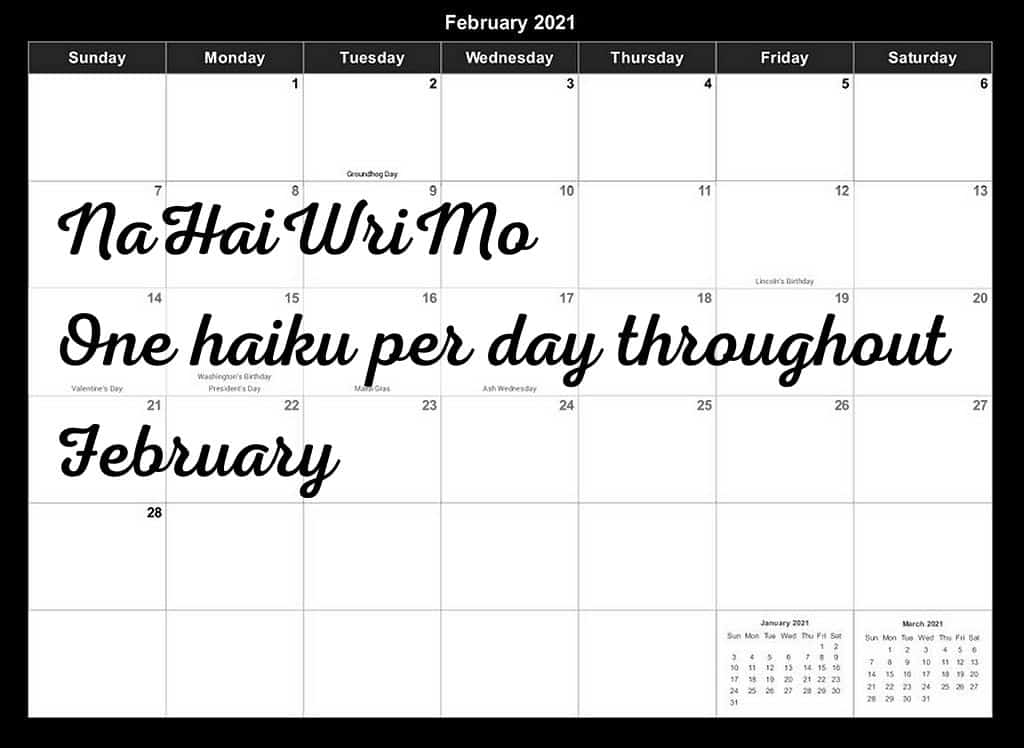NaHaiWriMo
If you have been a follower of this site for any time, you might have noticed that I love writing haiku.
I write and publish at least one haiku a day on a publication I created called 17 Onji. I have also written several books full of haiku with themes based on love, Mother’s Day, and Christmas.
It therefore came as a surprise to discover, only a few days ago, that February is National Haiku Writing Month (aka NaHaiWriMo), and that it was first celebrated way back in 2010.
Even if you don’t participate, you may already be aware of its “big brother”, National Novel Writing Month, usually shortened to NaNoWriMo. Its goal is to write a novel of at least 50,000 words – in just 30 days, as it takes place in November each year.
That’s a lot of writing! In fact, it works out to be 1,667 words per day. With an average typing speed of 35 words per minute, that means you need to be typing for around 48 minutes per day, every day. And while that may not sound too bad, that’s time many people are unable to commit to.
What Is NaHaiWriMo?
And that’s where NaHaiWriMo comes in. The creator of this haiku-writing challenge, Michael Dylan Welch, chose February because it’s the shortest month – and haiku is an ultra-short form of poetry. It’s a bit like poetry’s version of flash fiction or microfiction.
As with NaNoWriMo, there is no cost to take part, and nobody is tracking whether you achieve your goal or not. It’s entirely on an honour system.
And with NaHaiWriMo, the goal is simple – write at least one haiku for each day of February. Or, as you might put it in a haiku:

(You’ll notice that this does not conform to the 5-7-5 syllable count usually taught in the west. However, in Japanese, their syllables are shorter than the ones we are used to, so haiku with fewer than five, seven, and five syllables are acceptable.)
For me, writing a haiku each day is what I do anyway, and have done for many months now. I’m therefore not expecting this to be a challenge at all, barring extraordinary circumstances that prevent me from writing.
How Can You Participate?
You can write your daily haiku:
- in a good, old-fashioned notebook
- on your phone
- on a blog or site you run
- on a site such as Medium or AllPoetry
- on Facebook
- or wherever you want.
The organizers do encourage you to share some, but not all, of your haiku on their own Facebook page, but only if you want some feedback.
And if you’re not sure what to write about, they publish a daily writing prompt to give you inspiration. You’ll find these on the Facebook page mentioned above.
You can also learn more about NaHaiWriMo on their website.
What Next?
I shall definitely be participating since I already write a haiku each day. The trick for me will be to decide which haiku to share and which not to.
I shall also be adding the #NaHaiWriMo tag to anything I publish during this month’s challenge, regardless of where I might post it.
If you’re new to haiku, I would encourage you to check out the article I referenced above, Haiku – A Primer. Then, to try to take part in this challenge. (And if you’re already an occasional writer of haiku, maybe this is what you need to make it a regular habit.)
I am in the process of writing an article outlining ten benefits of writing flash fiction (compared to longer forms of story-telling), which is another of my writing passions.
While writing that, it occurred to me that haiku offers similar benefits (e.g. speed, any time/anywhere, sense of achievement). But there is one benefit that haiku provides that flash fiction does not. That’s how it forces you to be more observant of the world around you and your own experiences.
Haiku, traditionally, is seasonally based and is intended to convey an experience the poet had. Clearly, achieving this in so few words is a challenge. But it’s the brevity and the playing around with words until you find the best possible combination that appeal to me.
Anyway, NaHaiWriMo may be precisely what you need to start you on your haiku-writing journey – a journey without end, for me, at least.






